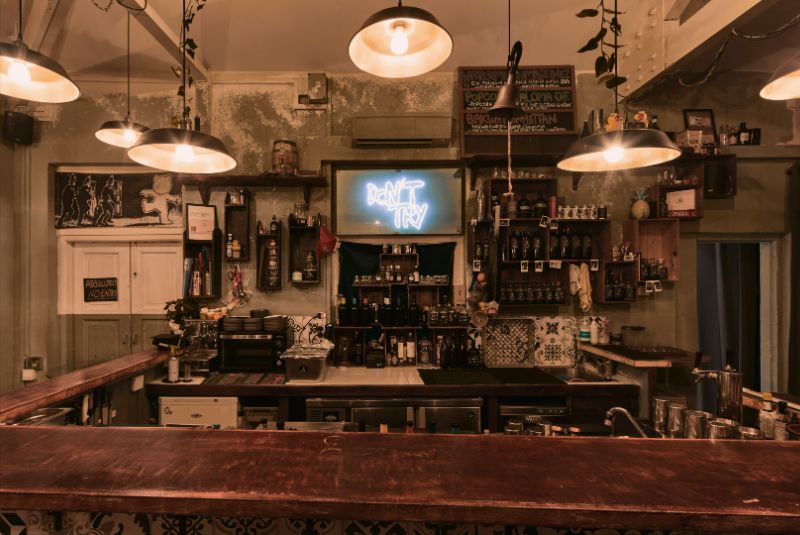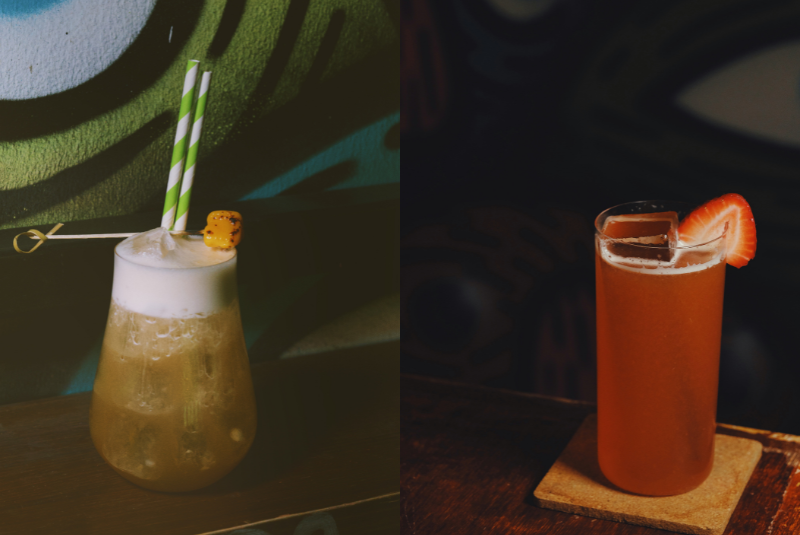Singapore’s Sago House has just been named the winner of the Michter’s Art of Hospitality Award ahead of Asia’s 50 Best Bars 2023, which will be revealed live from Hong Kong on 18th July. 50 Best speaks to Jay Gray, one of the bar’s three co-owners, about how the venue has cut a unique path to glory. From building the bar with their bare hands, to creating a one-of-a-kind atmosphere and serving drinks a third cheaper than the rest of the city, Sago House’s secrets to service success are served up below…
Sago House is somewhat of a rarity in the Singapore bar scene. Set on the third floor of a shophouse in what was once a down-at-heel part of town, it launched with zero debt and received no outside investment or financial injection before its 2019 opening. Its fit-out and furniture comprise almost entirely upcycled materials, which were crafted and shaped into a 50 Best-calibre bar at the hands of its co-owners Jay Gray, Desiree Jane and Abhishek C George.
Its hospitality philosophy is similarly unique. Sago House borrows on tropes and learnt behaviours from the owners’ pedigree working in award-winning bars across the globe, though brings with it originality and nuance in the way that it approaches the guest experience. Such is its interpersonal charm and the level of interaction afforded to guests, that Sago House has been named the winner of the Michter’s Art of Hospitality Award as part of Asia’s 50 Best Bars 2023, sponsored by Perrier.
The bar’s name is not a coincidence: Sago House is centred on a hospitality ethos that makes the guest feel ‘at home’. For Jay Gray, it’s at the core of everything the bar stands for. “Making people feel welcome is absolutely the most important thing for us and this is led by Desiree as our ‘super host’,” he says. “As soon as they walk through the door, they’re greeted with a ‘hello’ from everyone who’s on shift, which has really become a thing for us – as the night gets on the guests join in with the welcomes too and it’s a lot of fun.”
The interior of Sago House is designed to feel like a home, furnished almost exclusively by upcycled materials
The concept of ‘home’ to globetrotter Gray is of seminal importance. He was born into a military family that moved between the UK, US and mainland Europe as a child and throughout his formative years as a bartender, he brought a fleet-of-foot attitude into adult life, setting up base in Barcelona, Nottingham, Sydney, Hong Kong and, finally, Singapore.
Nine years into life in the city-state, Gray feels settled and much of Sago House is built on his own experience. “I worked as a whisky brand ambassador across Southeast Asia,” he begins. “I was on the road every other week for six years; it was a wild rodeo but I was ready to lay down roots… I had previously worked in hotel bars, but the formality, having to deal with purchasing officers and not being able to express my creativity wasn’t for me. The brand ambassador role helped me understand the back-end sales side of bars and how to work with suppliers in a more comprehensive way – being able to leverage and make the most of these relationships I’d built really helped in the early days of Sago. Particularly as we opened just before Covid hit.”
It was at the heart of Gray’s design for his debut bar that it would open debt-free – something he would soon appreciate with gusto as the pandemic advanced, shuttering hospitality businesses the world over. “We wanted to exemplify that you don’t need a million-dollar budget to open a great bar,” he says. “We wanted to show that you don’t have to sell percentages of your property and IP and get over-leveraged by investors and that you don’t have to deal with banks if you don’t want to. To be honest, as a young person trying to start a business, I was just so scared of debt.”
This anxiety was the driver behind Gray and the team’s extreme work ethic. As soon as they secured the Chinatown site, Gray and co-owner Jane – who were in a relationship at the time – moved into the bar, sleeping on a futon in what is now the office space. They then recruited the bar’s third co-owner, hospitality entrepreneur Abhishek C George, and set to work building Sago House.
Reuse, recycle, rehome
Upcycling was the name of the game from the beginning. Gray had some joinery experience and George was renowned for being ‘crafty’, having used recycled materials for a number of his other projects. “The key was to create something organic that was like a living room,” he says. “It had to have a factor that made people keep wanting to come back and for the bar to feel like home.
Sago House's cocktail menu changes every week, resulting in a bar with almost infinite revisitability
“We lucked out with the platform for the venue, which was likely to be one of the greatest expenses if we’d had to buy it. Lady Gaga had just performed at Marina Bay Sands hotel and the people there were getting rid of all the staging. It was brilliant for us and we salvaged the lot. It was super sturdy with compressed supports all over. It now makes the foundation for all the raised flooring, the banquettes and the sound proofing. It took a while for us to cut and sand it into shape, but it was, quite literally, free.”
The hard work, lack of overheads and need not to service any loans meant Sago House turned a profit quickly. “Within three months we were in the black and Desiree and I moved into an apartment – you definitely don’t want to be living in a bar when it’s operational,” says Gray. And what became of the office futon? “That thing got burnt.”
It also meant that savings could be passed on to the guest – arguably the most hospitable thing any bar can do. “Since opening, we’ve always been able to charge roughly 30 per cent less for our drinks than other bars in Singapore,” Gray explains.
The community built by this kind of act extends beyond the moment the guest has taken their last sip and settled their tab. “Constant contact is something we talk about a lot,” says Gray. “For example, if we knew someone was having a hard time post Covid, or if they’d lost their job, we would get in touch to invite them in for a night on us. In fact, I think it’s the fact we treat our guests as the real investors that has been the secret to our success.”
Now watch the video:
Asia’s 50 Best Bars 2023, sponsored by Perrier, will be revealed at an event in Hong Kong on 18th July at 8.30pm local time. The ceremony will be livestreamed on 50 Best Bars TV YouTube channel and 50 Best Bars Facebook page. Follow us on Facebook, Instagram, Twitter and YouTube to stay up to date with all the news and announcements.

